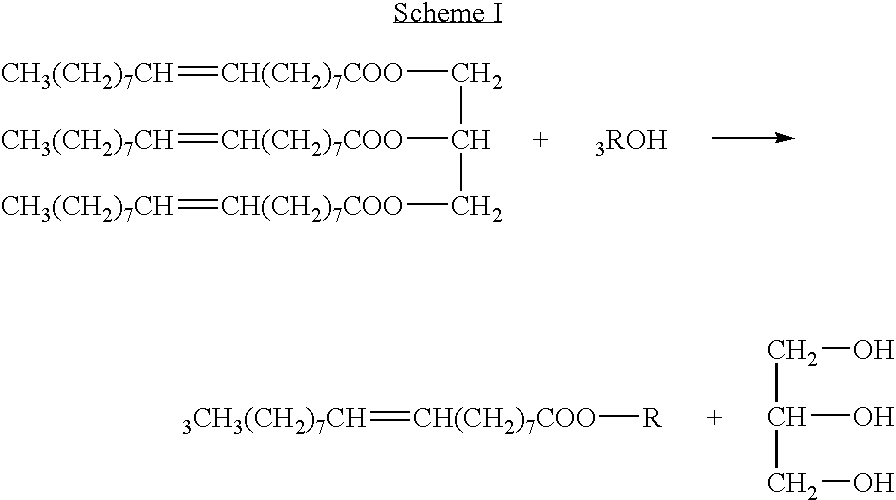Process for transesterification of vegetable or animal oils using heterogeneous catalysts based on titanium, zirconium or antimony and aluminium
a technology of heterogeneous catalysts and vegetable or animal oils, which is applied in the field of new technologies, can solve the problems of low performance level, low quantity of glycerin recovered, and patents that do not appear to provide a reasonable solution
- Summary
- Abstract
- Description
- Claims
- Application Information
AI Technical Summary
Benefits of technology
Problems solved by technology
Method used
Image
Examples
example 3
[0085] 25 g of rapeseed oil the composition of which was shown in Example 1, 25 g of methanol and 5 g of catalyst 1.3 were introduced into a 100 ml autoclave reactor provided with a stirring system and a temperature and pressure regulator. The medium was heated to 200° C. with stirring. The pressure reached 32 bars.
[0086] Samples were taken after 2 hours, 5 hours and 7 hours. For each sample, after filtering then evaporating off the excess methanol and eliminating the glycerol formed by decanting, the concentration of methyl esters was determined by steric exclusion chromatography. It was 68%, 89% and 95% respectively.
[0087] The titanium concentration in the methyl ester obtained was less than 1 ppm, which confirmed the heterogeneous character of the catalysis.
[0088] This allowed the ester obtained to be used as a fuel without having to carry out an additional treatment for purifying the methyl ester to eliminate traces of residual catalyst.
[0089] Under the same conditions, the ...
example 4
[0090] Example 3 was repeated, using 5 g of catalyst 1.6.
[0091] Samples were taken after 2 hours, 5 hours and 7 hours. For each sample, after filtering then evaporating off the excess methanol and eliminating the glycerol formed by decanting, the concentration of methyl esters was determined by steric exclusion chromatography. It was 67%, 87% and 94% respectively.
[0092] The titanium concentration in the methyl ester obtained was less than 1 ppm, which confirmed the heterogeneous character of the catalysis.
examples 7 to 9
[0093] Methanolysis was carried out in an apparatus comprising a fixed bed reactor, i.e. a filled column with a diameter of 1.9 cm and a length of 120 cm, heated using 3 sheaths surrounding the column. The oil and methanol were preheated in the column on 10 cm3 of glass beads and the reaction was carried out on 70 cm3 of catalyst 1.3. At the column outlet, 20 cm3 of tungsten carbide and 5 cm3 of glass beads were added. The upturned U device was constituted by a tube reactor, a cooler over the horizontal portion and a decanter, which constituted the second branch. Over the upper portion of the decanter, a gas purge system enabled the pressure to be regulated, i.e., to be maintained from start-up with nitrogen at the desired pressure of 15 to 60 bars. The decanter had a liquid purge at its lower outlet. When the decanter was half full, an automatic valve opens to partially evacuate the product obtained. Two pumps inject the alcohol and oil from bottom to top into the column at the des...
PUM
| Property | Measurement | Unit |
|---|---|---|
| weight ratio | aaaaa | aaaaa |
| weight ratio | aaaaa | aaaaa |
| pressure | aaaaa | aaaaa |
Abstract
Description
Claims
Application Information
 Login to View More
Login to View More - R&D
- Intellectual Property
- Life Sciences
- Materials
- Tech Scout
- Unparalleled Data Quality
- Higher Quality Content
- 60% Fewer Hallucinations
Browse by: Latest US Patents, China's latest patents, Technical Efficacy Thesaurus, Application Domain, Technology Topic, Popular Technical Reports.
© 2025 PatSnap. All rights reserved.Legal|Privacy policy|Modern Slavery Act Transparency Statement|Sitemap|About US| Contact US: help@patsnap.com



